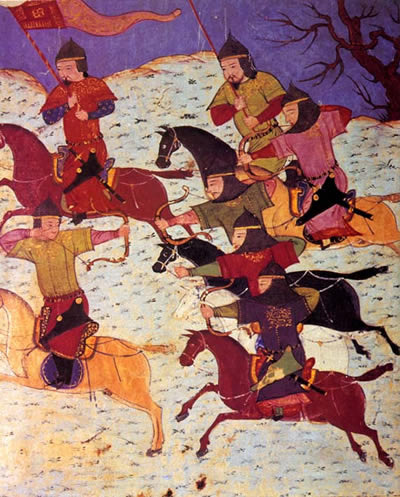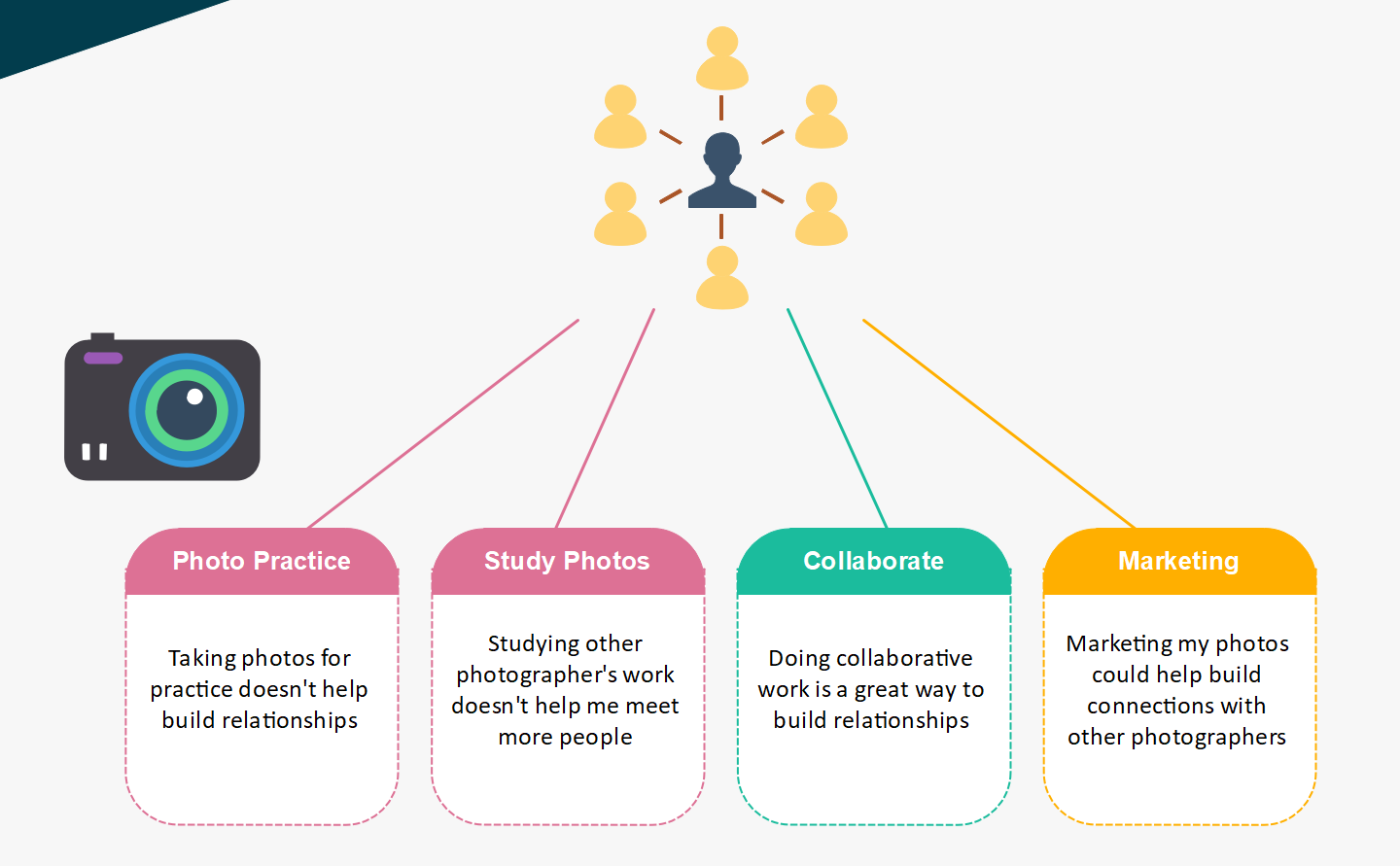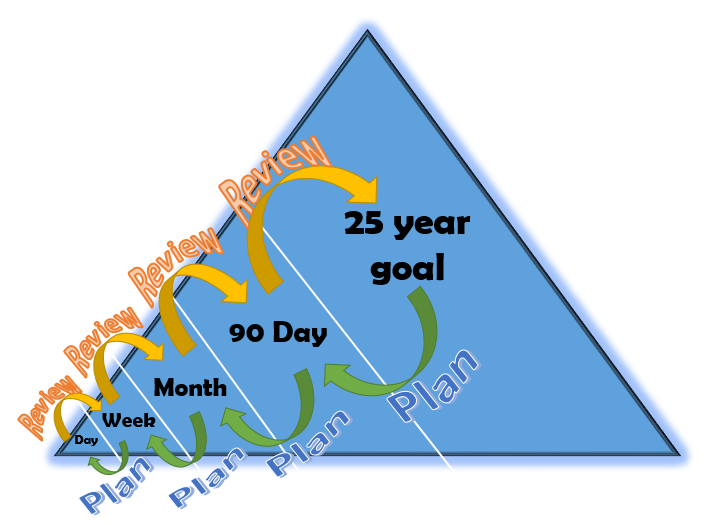Achieve your goals with vertical and horizontal cohesion
1216
The Mongol army storms across continental Asia and the Middle East, conquering all in their path. Even when greatly outnumbered, the Mongols seem unstoppable.
1294
The Mongol Empire spans from Eastern Europe to Korea, forming the largest land empire in history.

1965
The US deploys 200,000 Marines to Vietnam. “Combined with allied contributions, US forces overwhelmed the North Vietnamese numerically in all all traditional categories of military power.” [5]
1973
US troops withdraw from Vietnam
How could a nomadic people siege established settlements and end up controlling the largest land empire in history?
How could the North Vietnamese Army (NVA) with their unreliable supply lines and outmatched technology hold back the strongest military on earth?
We might point at strategy and tactics. The Mongols used psychological tactics to trick the enemy into thinking they were outnumbered. The NVA used guerilla tactics and were highly adaptable at the lowest levels, encouraging problem solving.
But strategy and tactics fall apart without a unifying factor.
Coherence. Cohesion.
The quality of forming a unified whole.
From Major Brendan McBreen’s ‘Improving Unit Cohesion’:
“The stability and cohesion of our units is a prerequisite for all other improvements” [1]
Cohesion is a prerequisite.
Without cohesion the Mongol army would not be organized enough train for their complex battle maneuvers, let alone perform them well in battle.
Without cohesion the NVA would have given up or been crushed. They were facing sporadic food supply, outdated technology, and lower troop count. The most brilliant tactics will fail if the people executing them aren’t aligned with the cause.
…
Here I’d like to discuss two types of cohesion:
- Vertical Cohesion - Cohesion from subordinate to leader
- Horizontal Cohesion - Cohesion amongst peers
Vertical Cohesion
Cohesion from subordinate to leader
If the soldier’s goals aren’t aligned with their leader’s, they’ll hesitate to follow their orders, do them begrudgingly, or defect.
Genghis Khan knew the value of vertical cohesion. The Mongol army was made up of many tribes. To ensure soldiers were loyal to Khan and not to their tribal leaders, he split members of each tribe and distributed them to different units, while forbidding transfers. Every soldier received a share of goods taken from conquered cities, further motivating their desire to follow [2].
To build camaraderie between soldiers and their commanders, everyone worked on the same menial tasks, regardless of rank. Even the aristocratic rank had few privileges [3]. When your squad leader sets up camp or cooks food with you, a strong bond forms, and you are more willing to follow them into battle.
This vertical cohesion allowed units to operate more autonomously, while still achieving the main objectives of the entire army.
Fast forward 700 years.
The North Vietnamese Army is considered “one of the most cohesive armies ever fielded…[the] development of military cohesion within the smallest units has not been equaled by other modern armies”
How could they accomplish such a feat? “Most cohesive armies ever fielded” is a strong statement.
From Wm. Darryl Henderson’s “Cohesion: The Human Element in Combat”:
“we cadres (small-unit leader) shared everything with our fighter, be it a small item, such as a bit of food, or a bigger thing, such as money…the friendship and unity that existed among the cadres and fighters were as close as among the cadres themselves”
Where the Mongol army used loot to motivate and shared menial tasks to bond, the NVA went a step further and made sure leaders were fulfilling all of their soldier’s needs.
“The high priority given within the NVA to satisfying the soldier’s physical, security, and social needs resulted in the NVA soldier’s identifying strongly with his immediate leaders and unit.” [5]
Horizontal cohesion
How else can we build cohesion? Cohesion amongst peers.
Even if you agree with your squad leader, your unit’s execution will falter if everyone in your unit hates each other.
The Mongols made sure that their units were bonded together. They used small 10 person units to make sure everyone in a unit knew each other well. Transfers between units were forbidden, and soldiers served their entire lives in a single unit. To prevent squabbles, “punishments for theft, murder, feuding, unauthorized looting, etc. [were] swift and brutal” [3].
It might seem violent today, but there’s nothing like skin in the game to motivate. “If one soldier ran from danger in battle, he and his nine comrades from the same arban [unit] would face the death penalty together” [4].
…
The NVA used an even smaller army unit: the three-man cell.
“The three-man cell is characterized by mutual aid between members which is based on … mutual affection among comrades … they take care of one another’s moral and physical lives”
This even smaller unit meant increased bonding between its members.
“The three-man cell is suitable … for approaching members and finding out their thoughts through exchange of personal feelings” [5]
Systems to Maintain Cohesion
Maintaining cohesion is just as important as developing it. Without systems to maintain vertical and horizontal coherence, the army could collapse at critical turning points in battle.
The mongols did it with their unit divisions, prohibition of transfers, and group punishments.
The NVA did it with their tiny cell divisions, close knit culture of sharing between cadre and soldier, and policy of requiring all to contribute feedback about previous battles.
Modern day armies understand the value of cohesion, and create standard operating procedures for generating cohesion.
The US Marines have a 13000 word document just outlining their procedures for establishing horizontal and vertical cohesion: MCO 3500.28 W ERRATUM MARINE CORPS UNIT COHESION PROGRAM STANDING OPERATING PROCEDURES
Cohesion is important enough to make sure it is systematically maintained.
Vertical and Horizontal Cohesion for Personal Goals
McBreen claims cohesion “is a largely unrecognized force multiplier” for the US military.
So what? I don’t run a military platoon.
When you see phrases like “largely unrecognized force multiplier” you should be doing a double take. In this post-knowledge work world, we need to be on the lookout for mental models and frameworks which yield exponential gains.
Can we apply cohesion to our own life? Sure can.
Vertical Cohesion:
The soldier’s goals must be aligned with the commander’s goals.
becomes
My day-to-day goals must be aligned with my long term goals.
If my long-term goal is to be healthy, but I am not exercising on a regular basis, I am not vertically aligned.
Make sure your day-to-day strivings align with your long term goals.
Horizontal Cohesion:
The soldier’s goals must be aligned with his comrade’s goals.
becomes
My day-to-day activities must be aligned and complimentary to each other.
If I’m exercising hard everyday, but eating McDonalds for breakfast lunch and dinner, my day-to-day strivings are not horizontally aligned.
In the late 20th century, psychologists studied ‘personality integration’: does being integrated lead to better psychological health What factors make someone feel ‘integrated’?
From Sheldon & Kasser’s “Coherence and Congruence: Two Aspects of Personality Integration”:
“[Integrated people] feel vital, satisfied with their lives, have a strong sense of self-esteem, are open to both their own experiences and the experiences of others, are relatively self-actualized, and experience more positive and fewer negative moods. They are more likely to engage in meaningful activities such as helping others or pondering their future”
Their paper defines both horizontal and vertical cohesion:
“Horizontal coherence occurs when success at particular goals contributes to success at other goals at the same level of the system”
“Vertical Coherence exists when lower level goals are consistent with or regulated by higher level goals”
When our day-to-day is disconnected from our long term goals, we feel detached. Think of the office worker, churning out TPS reports 8 hours a day, and coming home to watch TV for another 6. If their dream is to become a world class painter, the lack of vertical coherence is crushing.
An Example from my own life
One of my long term goals: “Build a strong network of motivated, smart people from a variety of fields”.
Outside of my full-time job, two of my hobbies are photography and this website. For the past two years, I’ve spent a lot of time (and money) on photography. Getting out and photographing everyday, trying new equipment and techniques, studying a lot of photographs. I’m not amazing, but I really enjoy the process, and I know what it would take to become a world-class photographer.
But “be a world-class photographer” isn’t one of my long term goals.
It’s easier for me to go out and take photos or research camera equipment than it is to sit down, stare at a screen, and write. Because of this I was spending something like 10 hours of photography to every hour of writing for this website.
But what if we think about these two activities through the lens of cohesion?
Grab a piece of paper, and write one of your long term goals at the top. Below that, write an area of your life, and all the actions that contribute to that area.

Here I’ve put my long term goal of networking at the top, and listed out the actions that make up photography: practice, studying photos, collaborative projects, and marketing. Now try to connect the low-level actions with the high-level goal. Which actions directly contribute to your long term goal? Which actions kinda-sorta do? Which actions don’t help at all?

You’ll probably find that there are actions that don’t directly contribute to your long-term goal, but contribute horizontally. Reading a book by myself doesn’t directly contribute to building a network, but if I didn’t read at all my writing would be horrid.
From these charts, it’s clear that writing is much more vertically aligned with my long term goal to build a network.
Could I accomplish my goal via photography, yes of course. Chase Jarvis is a great example of someone who has built a strong network through photography. But writing has a much stronger alignment with my goal, and effort spent there means I’m pushing on a longer lever.
I’ve swapped priorities, and am spending much more time working on this website than photography. I enjoy the act of photographing way more than writing. But weirdly enough, I feel better now that I am photographing less. Working on this website aligns better with my long term goals, and my feelings of satisfaction and contentment are stronger than before.
Systems To Maintain Cohesion
“Vertical cohesion…is built on clear standards.”
It’s too easy to get lost in the daily grind. To become reactive. To work on whatever comes up, instead of what you really want to be pursuing. Plan to be cohesive, then build a review system to maintain.
In Taylor Pearson’s ‘Antifragile Planning’, he outlines a method of goal setting and review. By connecting long-term goals with mid-term goals, and connecting mid-term goals with short-term goals, Pearson’s system ensures vertical cohesion, from 25 years in the future to today.
 Diagram from Taylor Pearson
Diagram from Taylor Pearson
His planning and review system is excellent, I use it to plan out my own goals. The initial setup does take a good chunk of time and hard thinking, but it’s well worth it.
If you’re apprehensive about a time consuming system and want to get started on something now, setting up a simpler process is still a step in the right direction.
Even if your system is a post-it with your long term goal written on it, make sure you have some way to maintain your cohesion.
Conclusion
Are you vertically integrated? Horizontally integrated? How can you shift your day-to-day activities to match your long term goals? Do you have a system in place to make sure you’re reviewing these ideas?
Let me know if you have any questions: james@jamesstuber.com or @uberstuber.
Takeaways
- Craft long term goals that are intrinsically satisfying (growth, intimacy, community)
- Vertically align your day-to-day strivings with your long term goals
- Horizontally align your day-to-day strivings with each other, so that they are complimentary
- Have a system in place to review coherence on a regular basis
Want to level up your productivity and start getting work done?
We built an interactive coach, available 24⁄7 to give you a feasible next step to improve your productivity skills.
Get the Digital Productivity Coach
Sources
- [1] McBreen - ‘Improving Unit Cohesion’
- [2] What Made the Mongol Army so Successful?
- [3] Were the Mongols really the unstoppable force that they are so often portrait as?
- [4] Wikipedia - Mongol Military Tactics and Organization
- [5] Henderson - Cohesion: the Human Element in Combat
- [6] Sheldon & Kasser -’Coherence and Congruence: Two Aspects of Personality Integration’